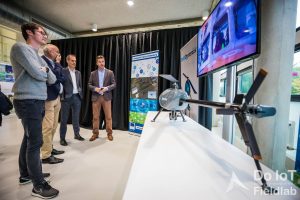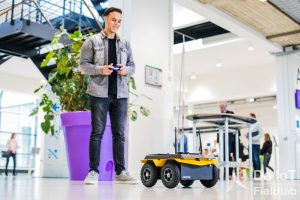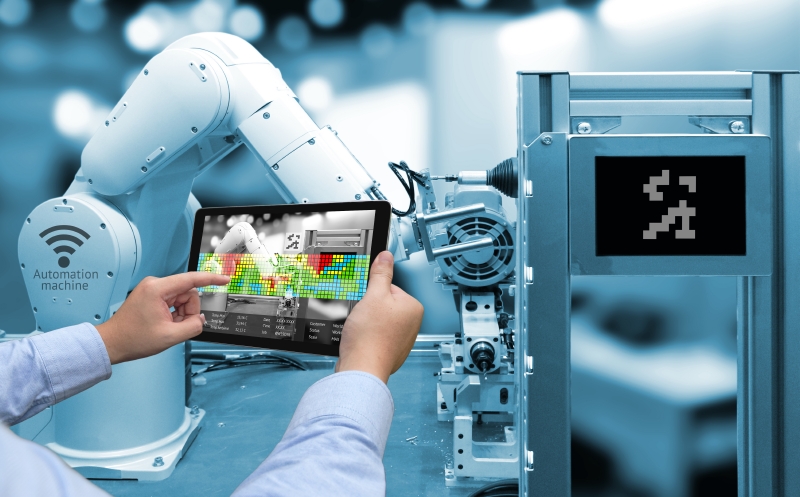The infinite game-changer to monetize your analytics opportunities
Does your factory still belong to the minor 11 percent saying that 5G is not on your radar? This means your factory is not planning to realize benefits from use cases like remote predictive maintenance, time-critical process optimization, automated visual quality inspection, connected cars, or augmented reality. According to Ericsson’s latest 5G study, more than two-thirds of companies aim to have these IoT use cases in production by 2021. And guess what? 2021 is going to start in just a couple of days. Discover our SAS vision on the most compelling reasons to take the next steps towards embracing IoT with 5G for revolutionizing your production process.
Today’s manufacturing landscape is highly under pressure as competitiveness is everywhere, both internally as externally. Margins continue to decrease, products are getting sophisticated with shorter lifecycles, workforces are aging, and customers are more demanding. Every day new technologies emerge to answer these challenges, so why should you care more in this case about the next generation 5G technology? Even if the nationwide roll-out of these networks are a couple of months away, preparations need to start now to maintain your role in tomorrow’s manufacturing industry. As William Arthur Ward once said “Don’t wait too long, you might miss your change”. SAS together with RoboHouse and Do IoT Fieldlab are here to offer your organization the opportunity to already test your own IoT use cases in a state-of-the-art 5G facility in Delft.
Highest potential for IoT in the manufacturing industry
As one of the most affected industries, manufacturing has the highest potential for IoT, automation and artificial intelligence. The single objective of every manufacturer: to transform your organization towards a smart factory-of-the-future by embracing digitization to improve productivity, profitability and safety on the work floor – also known as the fourth industrial revolution.
 However, adoption of IoT is currently limited due to several barriers of today’s infrastructure: limited connectivity, low response times, insufficient capacity and no real-time information. This hinders manufacturers to build and operationalize predictive and prescriptive models. Thanks to next-generation 5G technology, all these barriers simply fall away to develop your factory-of-the-future. But how to start with adopting this technology?
However, adoption of IoT is currently limited due to several barriers of today’s infrastructure: limited connectivity, low response times, insufficient capacity and no real-time information. This hinders manufacturers to build and operationalize predictive and prescriptive models. Thanks to next-generation 5G technology, all these barriers simply fall away to develop your factory-of-the-future. But how to start with adopting this technology?
The biggest trap is to just start without having the end in mind. What is your goal? Which data, preventive or prescriptive analytics, and implementation specifications are needed to realize returns from your IoT investments? Just installing sensors and capturing huge amounts of data without knowing what to do with this data will just have a negative impact on the expense side of your balance sheet.
Fully connected experience
Tomorrow’s factories are fully equipped with sensors producing, analyzing and sharing data to guide operators accordingly and are centered around a fully connected experience:
- Time-critical process optimization: connected machines to interoperate with each other, allowing for decentralized decisions and accelerate automated processes.
- Quality improvement: smart sensors and robotic systems can visually inspect product quality in real-time to reduce rework.
- from predictive to prescriptive maintenance: connect sensors on 5G to gain real-time information about the equipment performance and process data closer to its source. As a result, (un)planned downtime reduction by predicting failures in advance and facilitating remote diagnostics by your suppliers.
- Edge computing: accelerate response times and reduce massive data flows by transferring data processing and AI capabilities from central cloud servers into IoT devices themselves. Edge computing enables small, fast and reliable robots to complete repetitive or dangerous tasks.
- Remote control: integrate factory infrastructure, operational technology and resources with enterprise IT systems to optimize cost of operation while increasing uptime and safety procedures
- AR-enabled manufacturing: augmented reality glasses to assist or train operators and service technicians.
Factories-of-the-future
This list is exhaustive and unending with cases both within factories’ walls and along the value chain from procurement to distribution. All these cases have a significant impact on the way our employees, customers and suppliers live, work and interact.
They capture value from IoT investments by creating a single network of connected sensors to collect – analyze – and distribute data in real-time. Speed, performance and integration of these data steps will define your success in tomorrow’s industry.
 Therefore, today’s Industry 4.0 discussions should center around the need for fast, secure and reliable infrastructure. Current infrastructures are not sustainable as the number of new sensors, devices, and machines are increasing at an unseen speed. These infrastructures are the limiting factor to enhance existing IoT use cases as well as create new use cases. Putting analytics cases into production to monetize value requires a network 25 times faster than today’s 4G network and a delay or time lag reduced to virtually zero.
Therefore, today’s Industry 4.0 discussions should center around the need for fast, secure and reliable infrastructure. Current infrastructures are not sustainable as the number of new sensors, devices, and machines are increasing at an unseen speed. These infrastructures are the limiting factor to enhance existing IoT use cases as well as create new use cases. Putting analytics cases into production to monetize value requires a network 25 times faster than today’s 4G network and a delay or time lag reduced to virtually zero.
SAS, RoboHouse and Do IoT Fieldlab support you
The time to act is now. But how do you start to capture this opportunity at scale? Which new IoT use cases to explore from a business, technology and strategic perspective? And how do you bring existing analytics cases to a new level of performance? If you – as an innovator – want to take advantage of the convergence of IoT and 5G technology, SAS D[N]A Lab together with RoboHouse and Do IoT Fieldlab can support you in this journey.
As the barriers of IoT implementation are too high for your factory, we offer you the unique opportunity to test your IoT initiatives by making use of the state-of-the-art physical and digital environment at the TU Delft Campus (NL). The objective of this proof of value is twofold: generate analytics insights with the support of SAS® Analytics for IoT solutions, plus defining the infrastructure requirements for your own factory. With these insights and recommendations, your factory has taken its first practical steps towards the factory-of-the-future.
 Do IoT Fieldlab accelerates IoT innovations by facilitating groundbreaking research, by bringing the right parties together for innovation questions, and by supporting companies in the realization of new and better products and services.
Do IoT Fieldlab accelerates IoT innovations by facilitating groundbreaking research, by bringing the right parties together for innovation questions, and by supporting companies in the realization of new and better products and services.
SAS D[N]A Lab serves as an open innovation platform for companies, start-ups and scale-ups with a positive impact on society. It supports projects in projects in healthcare, academics, agrifood, nutrition, sports and climate
change related domains; helping innovations to become ‘enterprise-worthy’ and ‘scalable-ready’.

